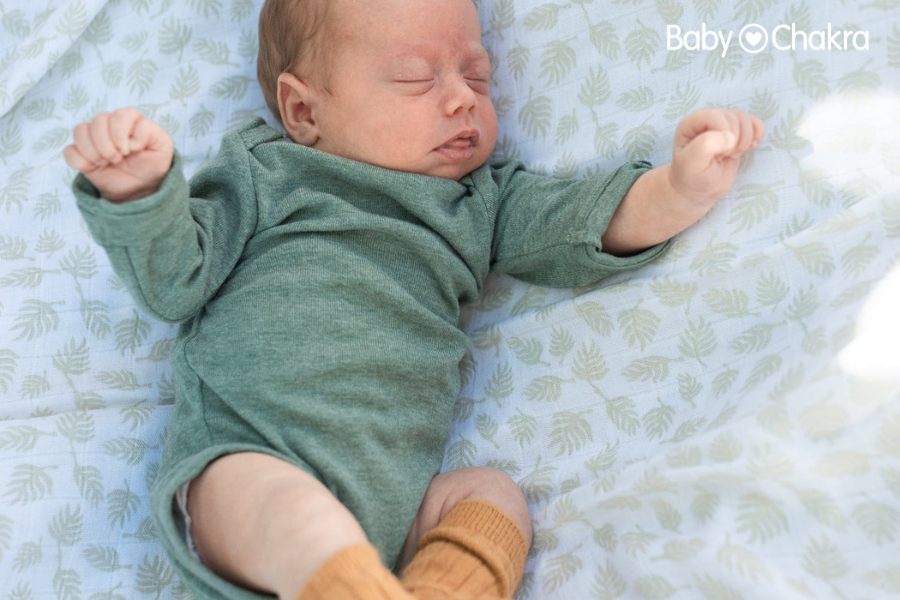
Tonic Neck Reflex In Babies: What You Need To Know
4 Apr 2022 | 5 min Read
Reema Shah
Author | 740 Articles
Newborns take different positions while lying on their back. As they grow, they develop different reflexes and movements. Reflexes are the movements that humans do involuntarily, without thinking. You can notice these reflexes in your baby from the moment he/she is born.
Here’s all you need to know about the different types of tonic neck reflexes and other common reflexes.
What are The Common Reflexes in Newborns?
- Rooting reflex — this is when the baby searches for a nipple on a breast or bottle.
- Sucking reflex — this happens when the roof of the baby’s mouth is stimulated.
- Grasping reflex — when the baby bends the fingers to grab.
- Startle reflex — when the baby responds to loud noises.
- Tonic reflex — happens when the baby is lying on its back.
What is Tonic Neck Reflex in Newborns
The tonic neck reflex starts about 18 weeks after conception. So even before the child is born, it starts right in the womb. It lasts until the baby is around five to seven months old and is one of the most easily recognized primary reflexes.
It is believed that your baby makes her/his way down the birth canal, because of the tonic reflex that happens during birth. After birth, it is the tonic neck reflex that guides the new baby to discover their hands and manage a hand-eye sync.
The tonic neck reflex in newborn is commonly referred to as the fencing reflex. When the baby is lying down and their head either turns to the right or left, the adjacent arm gets stretched, while the other arm bends right next to their head. This is when the baby looks like she is about to start fencing. It stops when the baby is about five to seven months old
Asymmetric Tonic Neck Reflex

Asymmetric tonic neck reflex, or ATNR, is experienced by babies as part of their brain development and is one of the primary reflexes. They help the baby to survive and grow and hence are important reflexes.
Asymmetric tonic neck reflexes mostly occur without any systematic order during the first few months after the baby is born. After ATNR, postural reflexes develop which are different from the former. Postural reflexes are comparatively more matured and assist in coordination, improving balance and sensory-motor development.
Asymmetric neck reflex happens when a newborn turns their head to the left or right but you might not notice them.
A baby starts to experience ATNR while still in the mother’s womb. This reflex can begin as early as 18 weeks into the mother’s pregnancy. It’s a crucial type of reflex that aids the baby to move through the birth canal during vaginal birth.
Symmetric Tonic Neck Reflex
The symmetric tonic neck reflex (STNR) is a reflex that usually happens during your baby’s first year. It commonly starts to fade by the time they reach 9 to 10 months.
Both “symmetric tonic neck reflex” and “symmetrical tonic neck reflex” are the same terms that paediatricians commonly use.
The STNR reflex aids the baby to learn to move the top half, and the bottom half of their body without depending on each other. The symmetric tonic neck reflex is typically known as the “crawling reflex”. The tonic neck reflex’s purpose is to enable the baby to make the transition from lying down to standing up on their hands and knees.
You’ll observe that your baby will go through this stage around six to nine months of age when they move from the stage of laying on the floor, or any other surface to crawling.
When your baby has reached the symmetric tonic neck reflex stage, you may see that as their neck and arms straighten, the legs bend. Similarly, when the neck and arms bend, the legs will straighten and vice versa. These movements are crucial for the baby to crawl and take its first steps.
Retained STNR and its Effects
The symmetric tonic neck reflex is connected to your baby’s head movements to their arm and leg movements. But if the baby continues this reflex, it can cause issues as they grow older. Some of the common long-term effects of a retained STNR are:
- Muscle tension in the neck causes headaches
- Baby faces difficulty in writing and reading
- Sitting still can be difficult
- Vision issues
- Delays in social and educational aspects

The common signs of retained STNR are:
- An improper hunched posture
- Baby skips crawling and goes straight to walking
- “W” posture of sitting, when the knees are in front of the body but the feet are out to the side of the hips
- The baby is seen walking on hands and feet which is referred to as “bear walking”
- Copying from a blackboard is difficult
Children grow and develop at different rates. But as parents, worrying about the child’s development is normal. Meet with your paediatrician to clear your concerns and get the right recommendations.
A


Related Topics for you
Suggestions offered by doctors on BabyChakra are of advisory nature i.e., for educational and informational purposes only. Content posted on, created for, or compiled by BabyChakra is not intended or designed to replace your doctor's independent judgment about any symptom, condition, or the appropriateness or risks of a procedure or treatment for a given person.
